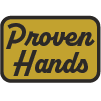How to Spot a High-Quality Leather Work Belt
Jun 30, 2025
How to Spot a High-Quality Leather Work Belt
If you're out there putting in real work, you don't need a belt that just looks tough you need one that can take a beating and keep going.
The problem is, not every leather belt is built the same.
Some are made to last.
Others? Just made to sell.
Here’s how to tell the difference so you don’t waste your money.

1. Check the Leather Type
The first thing to look at is the kind of leather used. You want full grain leather, nothing less. It’s the toughest, thickest cut you can get, made from the top layer of the hide. It holds up against wear, weather, sweat, and time.
Here’s the quick breakdown:
-
Full Grain Leather – The best you can get. Thick, strong, and gets better with age.
-
Top Grain Leather – Not bad, but thinner. Loses strength and character over time.
-
Genuine Leather – Sounds good, but it’s not. Usually glued-together scraps. Breaks down fast.
If the tag or product description doesn’t clearly say full grain leather, assume it’s not.
2. Look at the Thickness
A real work belt isn’t floppy or thin. It’s solid in your hands and strong on your waist. It should feel like it could hold up a tool pouch or a hammer loop, because it should.
For daily job use, a good belt is:
-
About 1.5 inches wide
-
At least 3.5mm thick
Anything thinner than that could twist, stretch, or even tear after a few weeks. Thickness matters especially when you’re bending, lifting, or carrying gear all day long.

3. Inspect the Stitching
Stitching is what keeps the belt from falling apart. If the thread goes, so does the belt. A quality belt has tight, even, heavy-duty stitching. There can be no loose threads, gaps, or missed spots.
What to look for:
-
Double stitching along the edges
-
No unraveling or skipping
-
Strong, thick thread not sewing string
If it looks like it was stitched together in a rush, put it back.
4. Check the Buckle and Hardware
The buckle takes a lot of daily strain. You want something solid that won’t snap or rust. Skip the belts with weak snaps, plastic clips, or thin metal.
Choose belts with:
-
Solid brass, steel, or nickel-plated hardware
-
Chicago screws or tight stitching (not cheap rivets)
-
Rust-resistant metal — especially if you sweat or work outside

A great belt should have replaceable hardware. If the buckle ever breaks, you fix it not toss it.
5. Feel It in Your Hands
You don’t need to be a leather expert, just use your hands. A good belt should feel dense, heavy, and strong. It shouldn’t fold like paper or feel like plastic.
Smell it too. Real leather has that rich, earthy scent. Fake stuff smells like chemicals or nothing at all.
Try to bend the belt. If it creases, cracks, or flakes, it’s trash. Real full grain leather bends without breaking.
Proven Hands Full-Grain Leather Work Belt
A work belt isn’t just something to hold up your pants, it’s part of your work gear. And like any other piece of gear, it should be built for the job.
When you choose full grain leather with solid hardware and tight stitching, you’re buying something that’ll outlast five cheap belts.
At Proven Hands, we hand make each of our Full-Grain Leather Work Belts and our brass hardware is 100% Made in USA.
Don’t settle. Buy the belt that works as hard as you do.
Which Proven Hands Full-Grain Leather Work belt is right for you?




